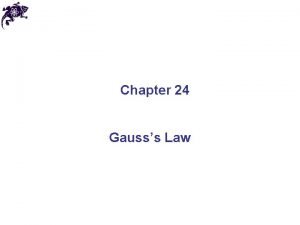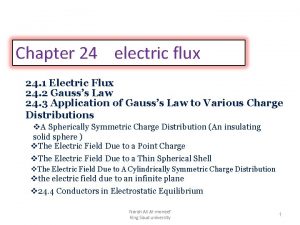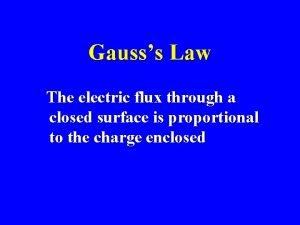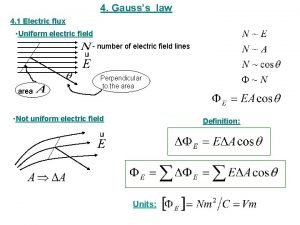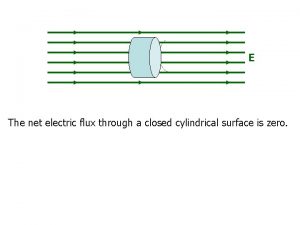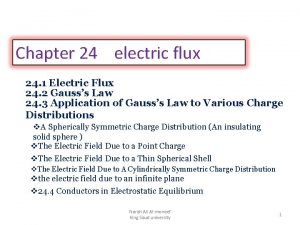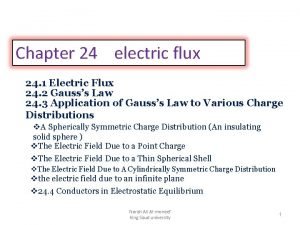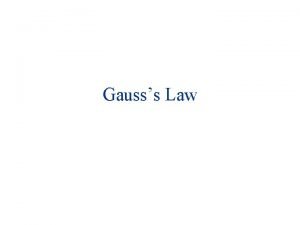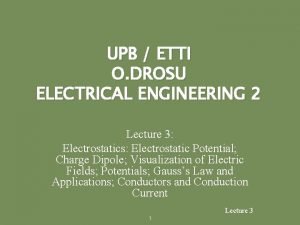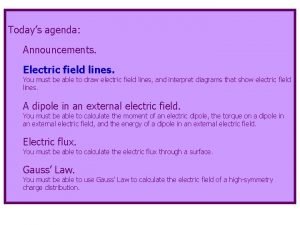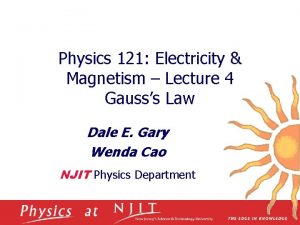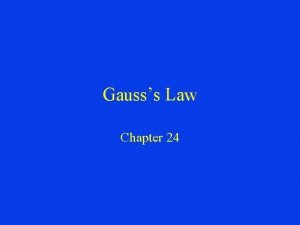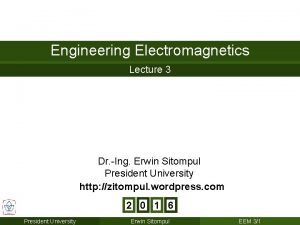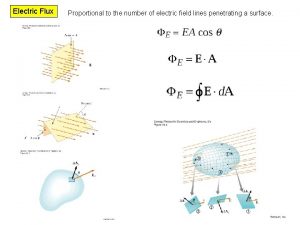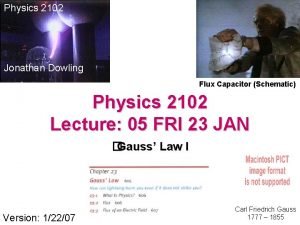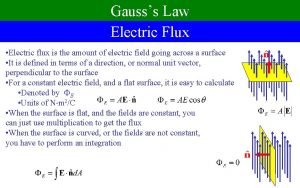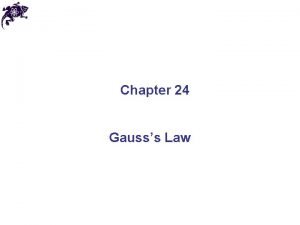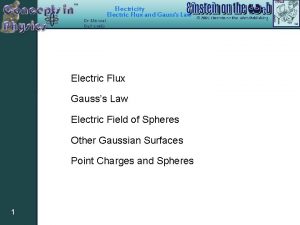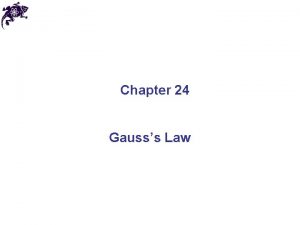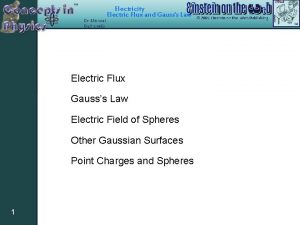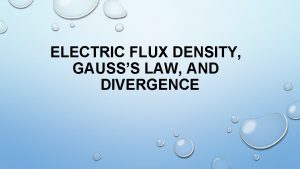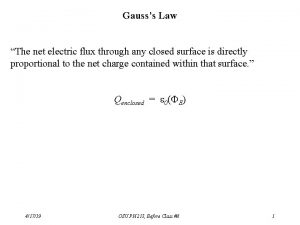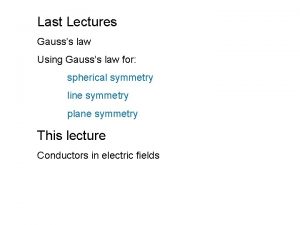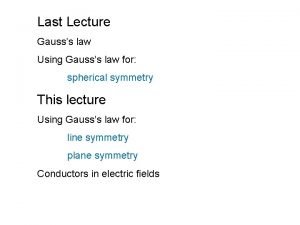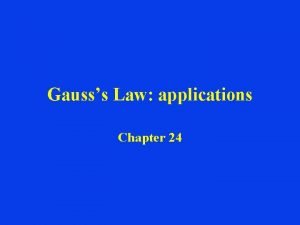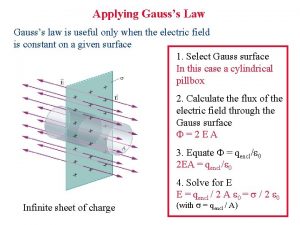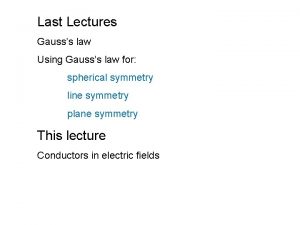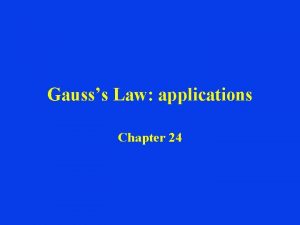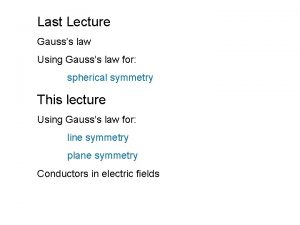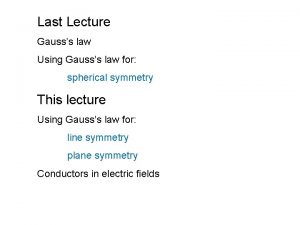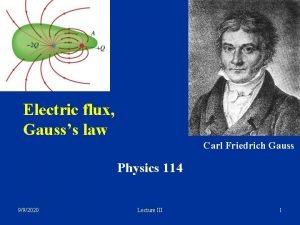Gausss Law The electric flux through a closed





















- Slides: 21

Gauss’s Law The electric flux through a closed surface is proportional to the charge enclosed

Definition of Flux • The amount of field, material or other physical entity passing through a surface. • Surface area can be represented as vector defined normal to the surface it is describing • Electric Flux is defined by the equation:

Electric Flux • The amount of electric field passing through a surface area • The units of electric flux are N-m 2/C

Carl Friedrich Gauss 1777 -1855 Yes it’s the same guy that gave you the Gaussian distribution and … Ceres t= 4. 6 year , d=4. 6 Au To give you some perspective he was born 50 years after Newton died (1642 -1727). Predicted the time and place of the first asteroid CERES (Dec. 31, 1801). Had the unit of magnetic field named after him and of course had much to do with the development of mathematics

Gauss’ Law in E& M • Uses symmetry to determine E-field due to a charge distribution • Method: Considers a hypothetical surface enclosing some charge and calculates the E -field • The shape of that surface is “EVERYTHING”

KEY TO USING Gauss’s Law • The shape of the surrounding surface is one that MIMICS the symmetry of the charge distribution …. .

The electric flux passing through a spherical surface surrounding a point charge Use a spherical surface with area Electric field for a point charge at r Due to symmetry, E and d. A are parallel and E is constant over all of A. So…

Gauss’s Law The previous example is true in general: The total flux passing through a closed surface is proportional to the charge enclosed within that surface. Note: The area vector points outward

The Gaussian Surface An imaginary closed surface created to enable the application of Gauss’s Law What is the total flux through each surface?

Solving problems with Gauss’s Law 1. Charge densities – It is convenient to define charge densities for linear, surface and volume charge distributions 2. Symmetry and coordinate systems – Choose that coordinate system that most nearly matches the symmetry of the charge distribution. For example, we chose spherical coordinates to determine the flux due to a point charge because of spherical symmetry.

Solving problems with Gauss’s Law 3. Determining the Electric Field from Gauss’s Law – Symmetry must be present in the charge distribution so that over the Gaussian surface E and A vectors are parallel and E is constant over the surface. Consider three examples: (1) the long straight line of charge, (2) the infinite plane sheet of charge, and (3) a charged sphere.

Example - Long straight line of charge Looking at the diagram (b), we can determine that the problem has a cylindrical symmetry. Therefore the Gaussian surface is a cylinder of radius r and length l. There are three surfaces to consider. The upper and lower circular surfaces have normals parallel to the z axis which are perpendicular to the electric field, thus contribute zero to the flux. The area to be evaluated for the integral is that of the curved sides of the cylinder, 2 prl. The charge enclosed is ll.

Example - Long straight line of charge Since the field has radial symmetry, it is also constant at a fixed distance of r.

Gauss’ Law: Determining the E-field near the surface of a nonconducting (insulating) sheet

Results of other geometries Uniformly charged dielectric (insulating) sphere Uniformly charged dielectric infinite plane sheet Can you derive these results?

Conclusions Gauss’ LAW 1. 2. Only the charge enclosed within a volume defined by a closed surface contributes to the net electric flux through the surface. That net flux through the surface is proportional to the charge enclosed within the volume.

Conclusions 3. Gaussian surface is an imaginary closed surface necessary to solve a problem using Gauss’s Law 4. Gauss’s Law can be used to determine the electric field of a charge distribution if there is a high degree of symmetry

Conclusion: Gauss’ Law and Conductors 5. Applying Gauss’s Law to the interior of an electrostatically charged conductor we conclude that the electric field within the conductor is zero 6. Any Net charge on a conductor must reside on its surface

Shell Theorems: Conductors 1) A shell of uniform charge attracts or repels a charge particle that is outside the shell as though all charge is concentrated at the center. 2) If a charged particle is located inside such a shell, there is no electrostatic force on the particle from the shell

Electric Field at surface of conductor is perpendicular to the surface and proportional to the charge density at the surface Shown that the excess charge resides on the outer surface of conductor surface. Unless the surface is spherical the charge density s (chg. per unit area) varies However the E-field just outside of a conducting surface is easy to determine using Gauss’ Law

Gauss’ Law can be used to determine Efield in cases where we have: • Spherical symmetry • Cylindrical symmetry • Planar symmetry
 Surface integral of electric field
Surface integral of electric field Electric flux
Electric flux Gausss law
Gausss law Gausss law
Gausss law Net electric flux
Net electric flux Hysteresis loop magnetism
Hysteresis loop magnetism Weber magnetic field
Weber magnetic field Notc contact
Notc contact Electric flux
Electric flux Electric flux
Electric flux Electric flux of a sphere
Electric flux of a sphere Electric flux density
Electric flux density Electric flux
Electric flux What is electric flux
What is electric flux Flux
Flux Electric flux density
Electric flux density Electric flux density
Electric flux density In the figure the net electric flux
In the figure the net electric flux Flux capacitor schematic
Flux capacitor schematic Flux capacitor schematic
Flux capacitor schematic A closed path that electric current follows is a(n) ______.
A closed path that electric current follows is a(n) ______. Newton's first law and second law and third law
Newton's first law and second law and third law
